March 10th Scots Book of Days
MARCH 10 241 BC. A Roman naval victory over the Carthaginians in the Battle of Aegusa ends the First Punic War. Two centuries later Rome will invade and conquer Britain, but not Scotia, instead building Hadrian’s wall.
1371 sometime in March. Sir Simon Locard died early in reign of reign of King of Scots Robert II (1371–1390).
A noble hart may have Nane Ease, Gif Freedom FailyE – Bruce Monument
“In 1329 a band of Scottish knights set out to fulfil the last wish of their dead King. Their leader, Lord James Douglas, carried the King’s heart in ‘ane cas of silver fyn, enamilit throu subtilite’ hung about his neck. Beside him rode Sir Symon Locard, carrying the key of the casket. Sir Symon had won fame and distinction in the wars against the English; and now he was entrusted with the key of the precious casket. following these events, Sir Symon changed his surname to Lockheart, later Lockhart, as the only holder of the key to the locked casket. He added a heart and fetterlock to the family coat of arms, and the motto Corda Serrata Pando: “I open locked hearts”. Sir Symon lived into his 70s, dying in 1371 at the beginning of the reign of Robert II (1371–1390). At the battle of Teba, Sir Symon captured a wealthy Emir, whom he held ransom. When the emir’s mother came to ransom him, she paid with an amulet, which she claimed had medicinal properties. The amulet could be dipped into water to make the water antipyretic, for fever reduction, and hemostatic to restrict bleeding. Sir Symon made use of the amulet in Spain and in Scotland, and its healing powers became widely known. The amulet became known as the Lee Penny, after the family seat of Lee Castle near Lanark, and remains in the possession of the Lockhart family. The story of the Lee Penny formed the basis for Sir Walter Scott’s 1825 novel The Talisman. Six centuries later, the shriveled relict was reburied in Melrose Abbey June 23, 1998. Independent.
- Lockhart of Bar 1297 2Miller 2Simmons 2Choate 2Sorensen
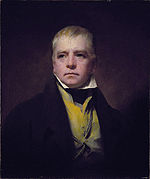 Raeburn’s 1822 portrait of Scott. On August 22nd and 23rd 1877, Wilford Woodruff, later reported that three knights, among others, Sir Walter Scott ‘called upon me, as an Apostle of the Lord Jesus Christ, in the Temple at St. George, [Utah Territory] two consecutive nights, and demanded at my hands that I should go forth and attend to the ordinances of the House of God for them.’ A high honor indeed!
Raeburn’s 1822 portrait of Scott. On August 22nd and 23rd 1877, Wilford Woodruff, later reported that three knights, among others, Sir Walter Scott ‘called upon me, as an Apostle of the Lord Jesus Christ, in the Temple at St. George, [Utah Territory] two consecutive nights, and demanded at my hands that I should go forth and attend to the ordinances of the House of God for them.’ A high honor indeed!
1502 Golf was subsequently permitted.
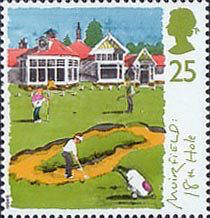 Muir Field 18th hole. 25 pence.
Muir Field 18th hole. 25 pence.
1599 never happened in Scotland, but it happened in England and Ireland.
1629 King Charles I (clans Stewart, Douglas, Drummond) begins 11 years of personal rule – the ‘Eleven Years Tyranny’ – by dissolving parliament.
1646 Ralph Hopton surrenders the Royalist army at Tresillian bridge in Cornwall.
1694 The Darien colony. Sometime in March – [Sir Walter Scott’s Tales of a Grandfather-59-26] HUMAN character, whether national or Individual, presents often to our calm consideration the strangest inconsistencies ; but there are few more striking than that which the Scots exhibit in their private conduct, contrasted with their views when united together for any general or national purpose. In his own personal affairs the Scotsman is remarked as cautious, frugal, and prudent, in an extreme degree, not generally aiming at enjoyment or relaxation till he has realized the means of indulgence, and studiously avoiding those temptations of pleasure, to which men of other countries most readily give way. But when a number of the natives of Scotland associate for any speculative project, it would seem that their natural caution becomes thawed and dissolved by the union of their joint hopes, and that their imaginations are liable in a peculiar degree to be heated and influenced by any splendid prospect held out to them. They appear, in particular, to lose the power of calculating and adapting their means to the end which they desire to accomplish, and are readily induced to aim at [Sir Walter Scott’s Tales of a Grandfather-59-27] objects magnificent in themselves, but which they have not, unhappily, the wealth or strength necessary to attain. Thus the Scots are often found to attempt splendid designs, which, shipwrecked for want of the necessary expenditure, give foreigners occasion to smile at the great error and equally great misfortune of the nation, I mean their pride and their poverty. There is no greater instance of this tendency to daring speculation, which rests at the bottom of the coldness and caution of the Scottish character, than the disastrous history of the Darien colony.
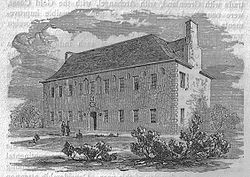 ‘Darien House’, headquarters of the Company of Scotland in Edinburgh; now demolished. (The Isthmus of Darien (later Panama, between the North and South American continents) was unsettled because it was infected with Yellow Fever, which killed off the settlers. Prevention and cure had to wait two centuries until Pasteur’s discovery of the microbial theory of disease, in the 1850’s, and United States Army Colonel Walter Reed’s clinical confirmation of the discovery of the fever’s transfer to humans by mosquitoes, in 1900. Defeat Mosquitoes, and defeat the Yellow Jack.)
‘Darien House’, headquarters of the Company of Scotland in Edinburgh; now demolished. (The Isthmus of Darien (later Panama, between the North and South American continents) was unsettled because it was infected with Yellow Fever, which killed off the settlers. Prevention and cure had to wait two centuries until Pasteur’s discovery of the microbial theory of disease, in the 1850’s, and United States Army Colonel Walter Reed’s clinical confirmation of the discovery of the fever’s transfer to humans by mosquitoes, in 1900. Defeat Mosquitoes, and defeat the Yellow Jack.)
[The Company of Scotland Trading to Africa and the Indies, also called the Scottish Darien Company, was an overseas trading company created by an act of the Parliament of Scotland in 1695. The Act granted the Company a monopoly of Scottish trade to India, Africa and the Americas, similar to English charter companies’ monopolies, and also extraordinary sovereign rights and temporary exemptions from taxation.] More later.
 L50 Bank of Scotland Tercenterary with Sir Walter Scott.
L50 Bank of Scotland Tercenterary with Sir Walter Scott.
1751 did not occur in England, Ireland, British North America, and British colonies, as 1751 only had 282 days due to the Calendar Act of 1750. But 1751 did occur in Scotland, as 1751 had 365 days. The world’s oldest lunar “calendar” is in an Aberdeenshire field.
1801 The first official census is held in Britain, revealing a population of approximately 10 million people. England’s population was usually ten times higher than Scotland.
1823 Admiral George Elphinstone, 1st Viscount Keith died. Born 7 January 1746. British admiral active throughout the Napoleonic Wars. Received the Rosetta Stone at the capitulation of Alexandria Egypt 30 august 1801 on the Nile. Fifth son of the 10th Lord Elphinstone, he was born in Elphinstone Tower, near Stirling, Scotland. During the war in America (1776-1783) he was with a naval brigade at the occupation of Charleston, South Carolina Possibly receiving the surrender of Andrew Pickens, Colonel of the South Carolina militia, who was paroled after the fall of Charleston. Keith served in Parliament from Dunbartonshire and Stirlingshire, between 1783 and 1793. He was elected a fellow of the Royal Society in 1790
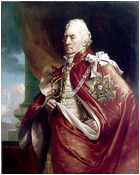 George Elphinstone, 1st Viscount Keith. He was twice married: in 1787 to Jane Mercer, daughter of Colonel William Mercer of Aldie; and in 1808 to Hester Thrale, daughter of Henry Thrale and Hester Thrale, who is spoken of as ‘Queeney’ in James Boswell’s Life of Johnson and Mme d’Arblay’s Diary.
George Elphinstone, 1st Viscount Keith. He was twice married: in 1787 to Jane Mercer, daughter of Colonel William Mercer of Aldie; and in 1808 to Hester Thrale, daughter of Henry Thrale and Hester Thrale, who is spoken of as ‘Queeney’ in James Boswell’s Life of Johnson and Mme d’Arblay’s Diary.
- Keith of Dunnottarin Kincardine 1109 2Stewart 2Campbell 2Montgomery 2Blair 2Cochrane 2Miller 2Simmons 2Choate zoe Blair5
Boswell of Auchinleck Ayr 13c 2Arnot2Colville 2Semple 2Montgomerie2Cochrane 2Miller2Simmons 2Choate David Marcus Olaf ToaG
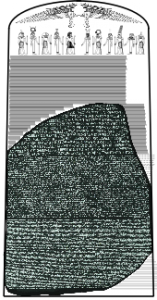 Image of the Rosetta Stone placed in an image of the original stele from it came.
Image of the Rosetta Stone placed in an image of the original stele from it came.
1830 Scots Roman Type, prepared in Glasgow Scotland, and shipped to a foundry in Albany New York, then delivered to the E. B. Grandin Printing company in Palmyra New York, according to the Crandall Gutenberg Printing Museum in Provo Utah. The Scots Roman type is the font used to print the first edition of the Book of Mormon, a record of the ancient natives of the Americas. The contract with E. B. Grandin’s print shop to print the book was signed on Tuesday 25 Aug 1829, and the completed book was on sale by Friday 26 March 1830. Typesetter John H. Gilbert selects type and inserts commas, periods, and other punctuation as Gilbert reads Oliver Cowdery’s hand written copy. One form signature of 16 pages, in quantities of 5,000 copies will be printed, 37 signatures, a form per 6 day, 11 hour per day week. Meridian Magazine (14 Apr 2005). http://www.johnpratt.com/items/docs/lds/meridian/2005/printing.html
34th form of 16 pages printed. Somewhere in Ether.
1912 Salt Lake City community. David McKenzie b 27 Dec 1833, Edinburgh, MidLothian, Scotland, – died 10 Mar 1912, Salt Lake City, Salt Lake, Utah, performed on stage at the Social Hall and was recognized by the celebrated American critic John McCullough as the most talented local actor as well as the best Polonius McCullough had ever seen portrayed. HISTORY SCOTLAND – MAGAZINE
2007 “UN slams capital’s Quartermile”. The Scotsman. Quartermile is the marketing name given to the mixed use redevelopment of the former Royal Infirmary of Edinburgh site, in Lauriston, Edinburgh. The project is a joint venture between Gladedale Group and the Bank of Scotland. The Royal Infirmary of Edinburgh, or RIE, and the Edinburgh Royal Infirmary, or ERI, was established in 1729 and is the oldest voluntary hospital in Scotland. The new buildings of 1879 were claimed to be the largest voluntary hospital in the United Kingdom, and later on, the Empire. The hospital moved to a new 900 bed site in 2003 in Little France. It is the site of clinical medicine teaching as well as a teaching hospital for the University of Edinburgh Medical School. It is currently run by NHS Lothian. In 1960, the first kidney transplant performed in the UK was performed at the Royal Infirmary of Edinburgh by surgeon Michael Woodruff.[ In 1964, the world’s first coronary care unit was established at the Royal Infirmary of Edinburgh by Dr. Desmond Julian. It is the only site for liver, pancreas and pancreatic islet cell transplantation and one of two sites for kidney transplantation in Scotland. Wikipedia
Utah Standard News depends on the support of readers like you.
Good Journalism requires time, expertise, passion and money. We know you appreciate the coverage here. Please help us to continue as an alternative news website by becoming a subscriber or making a donation. To learn more about our subscription options or make a donation, click here.
To Advertise on UtahStandardNews.com, please contact us at: ed@utahstandardnews.com.


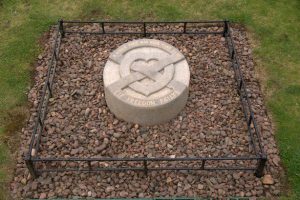
Comments - No Responses to “March 10th Scots Book of Days”
Sure is empty down here...